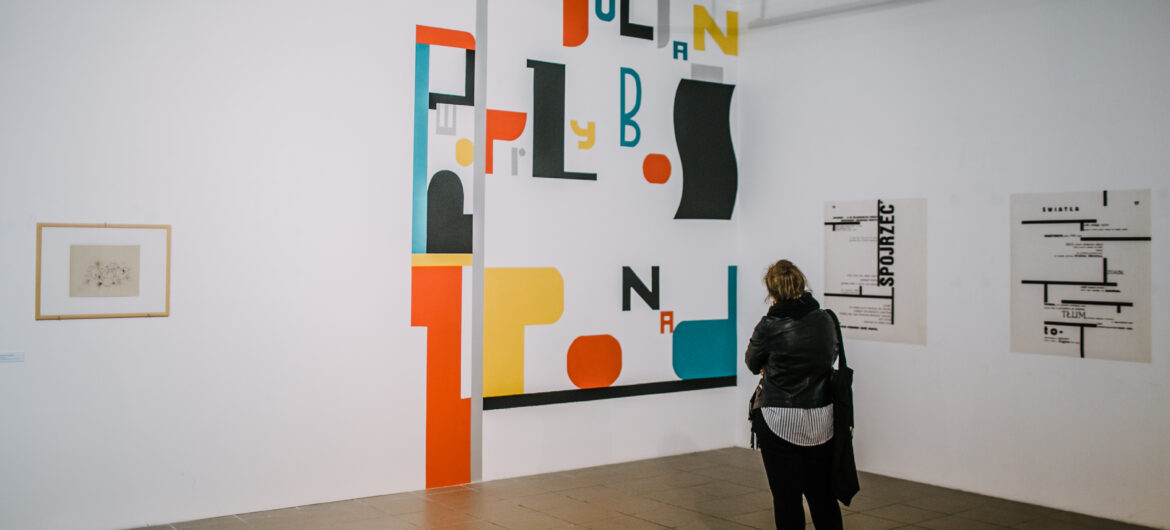
Line and Chaos — the World in Spatial Compositions
27.10 — 3.12.2017
BWA Contemporary Art Gallery in Katowice
Curator: Marek Zieliński
Exhibition within the ⅩⅩⅦ Ars Cameralis Festival
The exhibition ‘Line and Chaos’ presents the undertakings, works and achievements of a couple of generations of artists from the avant-garde movement in Polish art. There is a special focus on its Silesian scene, the emergence of which was sparked by Julian Przyboś, who stayed in Cieszyn from 1927 to 1939, teaching in the local schools — first in the Państwowe Gimnazjum im. A. Osuchowskiego, and later in the Państwowe Gimnazjum Matematyczno-Przyrodnicze. At the time, Julian Przyboś was fascinated by revolutionary ideas that defied the then common assumptions about art, and he made conscious efforts to instil them into his students. He met Władysław Strzemiński, a key figure in the Polish avant-garde, whose theory of Unism is a significant contribution to the world of art. After the war, Julian Przyboś turned into an eager defender of innovative approach in art, as exemplified by his foreword to Strzemiński’s ‘Theory of Seeing’.
It was then that Przyboś and Strzemiński initiated a group called St-53, triggering the birth of avant-garde art in Silesia. Apart from painters, the group included architects, writers and art historians. Their primary aim was to find techniques and means of expression that would be congruous with the new understanding of art — as proposed in ‘Theory of Seeing’. The name of the group is an acronym, with its first element, the letters ‘St’, tied to three notions: they are the first letters of the surname of the group’s ‘spiritual’ master — Strzemiński; they point to the studio character of the group — combining work and self-education; finally, they indicate the physical location of the group — Katowice, which was then renamed Stalinogród. The digits in the acronym, 53, stand for the date when the group was formally established. St-53 disassembled in 1959, after ideological disputes made its members follow artistic paths of their own choice.
Apart from showing Władysław Strzemiński’s works, the exhibition is meant to recall other outstanding members of the group, including Klaudiusz Jędrusik, Urszula Broll, Zdzisław Stanek and Zygfryd Dudzik. St-53 was one of the very first manifestations of dissent against the domination of Social Realism in Polish art.
Considering art as a sphere that reproduces most human behaviour, avant-garde theoreticians demanded that artworks should use purified forms, reflecting the logic of mechanical structures and dynamic new cities. A social revolution entailed a revolution in art, and one of the results were pioneer experiments in typography. The blending of image and word inspired Zenon Moskwa to conduct his reconstructive operations on ruptured signs. Functionality of language became confronted with words that were completely stripped of meaning and could be therefore considered in a purely formal context, leading Moskwa to criticize the denotation — the relationship between the reality and the sign that represents it.
From the 1970s onwards, the Cieszyn avant-garde tradition was to be continued by a group of artists who stamped their mark on the local branch of the art department of the University of Silesia. A notable member of this group was Andrzej Szewczyk, a spiritual leader of the informal group called “Gacki” or ‘grupa cieszyńska’ [the Cieszyn group]. Szewczyk was one of the most interesting characters in Polish post-war art. Never ceasing in his attempts to abandon traditional forms and structures in pictures, Szewczyk turned his entire focus on the painting process, which included the vital element of recording signs — so called book writing. Apart from Szewczyk, exhibited artists include Marek Chlanda, Jerzy Wroński, Krystyna Pasterczyk, Piotr Lutyński, Krzysztof Morcinek and Marek Kuś. This part of the exhibition is based on the reminiscences of the galleries that presented this innovative art at that time and constituted the most prominent centres of artistic activity in the region, such as Galeria Uniwersytecka Instytutu Sztuki in Cieszyn, Galeria Miejsce and Galeria Szara in Cieszyn, Kronika in Bytom and the BWA Gallery in Katowice.
Another group of works at the ‘Line and Chaos’ exhibition demonstrates artistic activity in various spaces, referring to the land-art tradition. Among their authors are graduates of the Art Institute in Cieszyn that are now leading artists in the Silesian region, such as Sławomir Brzoska and his student Michał Smandek, who uphold their connection with the Academy of Fine Arts in Katowice. Their work involves process and research, with both being related to their chosen strategy of blending. These assignments are journeys and often require artists to engage in exhausting physical contact with specific places. Unobtrusive art interventions in outdoor spaces are part of their quest to redefine art and its scope. They manage to blur the border between doing art and documenting the existing situations as artworks per se.
The newest Silesian art section would not be complete without multimedia installations by artists such as Wojtek Kucharczyk, Joanna Rzepka-Dziedzic and Łukasz Dziedzic.
→ Artists participating in the exhibition: Władysław Strzemiński, Julian Przyboś, Klaudiusz Jędrusik, Urszula Broll, Zdzisław Stanek, Zygfryd Dudzik, Krystian Burda, Ludwik Poniewiera, Zenon Moskwa, Andrzej Szewczyk, Marek Chlanda, Jerzy Wroński, Krystyna Pasterczyk, Piotr Lutyński, Krzysztof Morcinek, Marek Kuś, Sławomir Brzoska, Michał Smandek, Joanna Rzepka-Dziedzic , Łukasz Dziedzic & Wojtek Kucharczyk
→ Advisory committee for the project and authors contributing for the exhibition catalogue: Zbigniew Machej, Tadeusz Sławek, Jerzy Kronhold, Ewa Gołębiewska and Joanna Wowrzeczka.
→ The exhibition was subsidized by the Ministry of Culture and National Heritage.